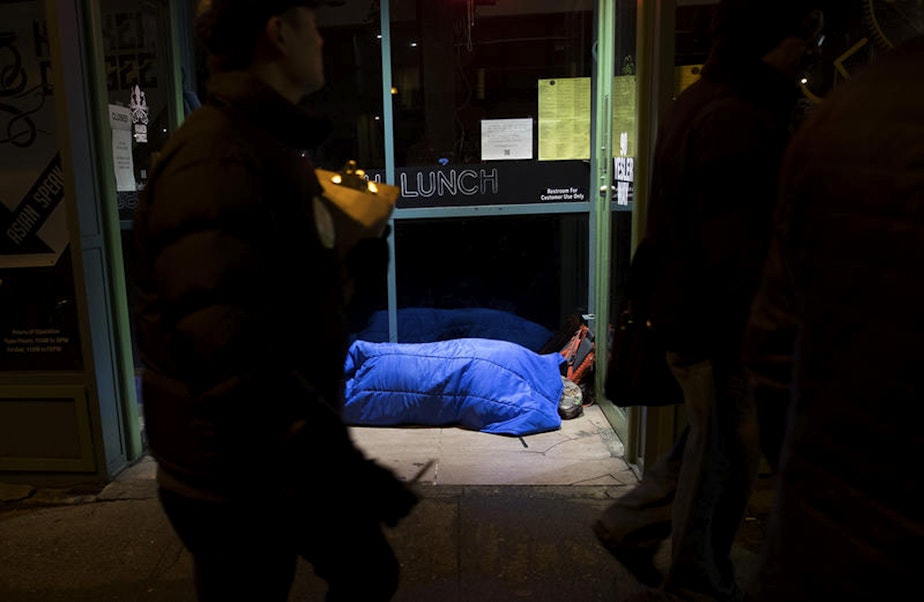Fact check: Actually, Seattle doesn't know how many people it's getting off the streets

How many people got out of homelessness with the help of city-funded programs last year?
It seems like a simple question, but it’s one the city of Seattle can’t currently answer — despite what you may have heard from the mayor.
Numbers around homelessness matter because Seattle spends tens of millions of dollars on homelessness each year — and as the crisis continues, the city has faced cries for greater accountability.
Earlier this month, Mayor Jenny Durkan said during her State of the City address that in 2018, the city helped "more than 7,400 households move out of homelessness and into permanent housing."
But that’s not entirely accurate, as was first reported by Erica C. Barnett.
Here's why:
That 7,400 number? It actually represents two different things.
Sponsored
It includes more than 1,800 households that were already in permanent supportive housing – housing with on-site support services for people who are formerly homeless and face significant challenges – and were able to maintain that housing throughout the year.
And it includes more than 5,600 exits from services like shelters or housing voucher programs to permanent housing.
It's the ‘exits’ piece that gets complicated.
The city did record more than 5,600 exits from city-funded programs to permanent housing in 2018. But that number doesn't reflect the number of unique "households," a term that can either represent an individual or multiple people in a family, being moved out of homelessness.
So those 5,600 exits? They could— and likely do—contain duplicates of the same person or the same family exiting multiple programs.
Sponsored
Example: If three different city-funded programs contribute to a single individual or family getting into an apartment, that single individual or family is counted as ‘exiting’ three times.
It’s like counting graduations by the number of classes a student has completed that successfully helped them move from high school to college.
It tells the city how their different programs are performing, but it doesn't give an overall view of the impact being made on the streets.
When asked if he thought the public understood the way the city's been communicating about homelessness, Jason Johnson, the interim director for the city's Human Services Department (HSD), said he hoped so — but evidently not.
"It is our job to continue to get better at communicating a variety of different data sets and stories out to the public," Johnson said.
Sponsored
City officials also said that data around homelessness is challenging and, in some cases, limited.
They said, for example, they could work out how many unique households were housed in 2018 with help from city-funded services, but it would take a lot of work to pull those individual threads out of complex data from King County's Homeless Management Information System– a federally required database that collects information about people accessing homeless services.
And they don’t know, on average, how many programs are involved in getting people into housing.
KUOW previously reported that 5,600 households had been housed in 2018, without this context.
When news organizations, including KUOW, started asking new questions about what’s counted in that number, data performance and evaluation manager for HSD Ali Peters said that people go in and out of programs funded by the city and King County —and that also complicates things.
Sponsored
And, she said, the question about how many people are getting out of homelessness "isn't one that the city of Seattle should be answering on its own."
HSD spokesperson Meg Olberding said the city is likely to change the way it looks at the data and presents it. And officials acknowledged that they need to do better at ensuring communication is clear and accurate.
Still, officials said homelessness data can be sliced many ways. And they stressed the way they’re slicing it is useful. Looking at it this way allows the city to gauge how the programs they’re funding are performing.
In 2017, the city competitively bid more than $30 million in homeless services contracts for the first time in more than a decade. Part of the deal was that providers had to hit certain benchmarks and exit a certain number of individuals and families to housing.
So it made sense to track those exits. And that’s why the city decided to look at the data the way it currently does.
Sponsored
“What it helps me understand is whether or not the investments we’re making in certain programs, and in certain program areas, are having impacts,” HSD's Johnson said.
With thousands of people still living on the streets, Johnson said there’s still a lot of work to be done.
But he said the 2018 data is positive, showing a 30 percent increase in program exits to housing over 2017.
More than 25,400 unique households got help from city-funded services last year, according to city officials. That’s a 7 percent increase over 2017.
Johnson said programs also furthered racial equity goals, serving more American Indian, Alaska Native and African American people.
And the city increased the number of spots available in 24-hour shelters with services. These kinds of shelters have exit rates to housing that are five times the rates for basic shelters, according to the city.
“We feel like we’re moving the needle in a number of ways because of the investments we’re making,” Johnson said.
Nevertheless, during a media briefing Monday, Mayor Durkan expressed her frustration with the currently available data.
Durkan stressed that the way to improve data, and system efficiency, is to move forward with consolidating the current fragmented system into a single regional body.
“Our data system is not only imperfect but it starts to get in the way of our ability to solve the problem,” she said.




